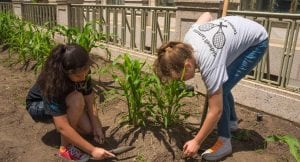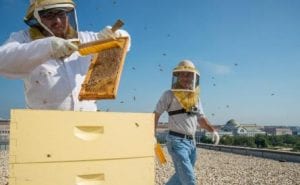The concept of the People’s Garden is generally one that’s tended by volunteers and a lot of the food from it donated to local food banks and such. Cathy Isom gives us why the number of so called “People’s Gardens” has grown so rapidly in the last seven years and why we could soon be seeing even more of them soon. That’s coming up on This Land of Ours.
People’s Garden
From: USDA
The People’s Garden Initiative
Secretary Vilsack began the People’s Garden Initiative, named in honor of President Lincoln’s description of USDA as the “People’s Department,” with one garden at USDA Headquarters in 2009. He later challenged all USDA employees to create gardens at USDA facilities worldwide or within the communities where they work. The Initiative has since grown into a collaborative effort of over 1,300 local and national organizations all working together to establish community and school gardens that incorporate sustainable practices and improve communities across the country.
Through this Initiative USDA demonstrates that the simple act of planting a garden can help unite neighborhoods in a common effort and inspire locally-led solutions to challenges facing our country – from hunger to climate change.
USDA Headquarters People’s Garden
 On Lincoln’s 200th birthday, February 12, 2009, Secretary of Agriculture Tom Vilsack launched the People’s Garden Initiative by breaking ground on the first People’s Garden at the U.S. Department of Agriculture Headquarters in Washington, DC. The garden includes the entire grounds of USDA’s Jamie L. Whitten Building and South Building, which extend east to west from 12th Street to 14th Street. The northern and southern boundaries are Jefferson Drive and C Street. This prominently placed urban “outdoor museum” of sustainable gardening practices is on the National Mall, just steps away from the Washington Monument. It draws millions of visitors year round. From May to October, visitors can shop at the adjacent USDA Farmers Market located at the corner of 12th Street and Independence Avenue, S.W.
On Lincoln’s 200th birthday, February 12, 2009, Secretary of Agriculture Tom Vilsack launched the People’s Garden Initiative by breaking ground on the first People’s Garden at the U.S. Department of Agriculture Headquarters in Washington, DC. The garden includes the entire grounds of USDA’s Jamie L. Whitten Building and South Building, which extend east to west from 12th Street to 14th Street. The northern and southern boundaries are Jefferson Drive and C Street. This prominently placed urban “outdoor museum” of sustainable gardening practices is on the National Mall, just steps away from the Washington Monument. It draws millions of visitors year round. From May to October, visitors can shop at the adjacent USDA Farmers Market located at the corner of 12th Street and Independence Avenue, S.W.
The garden is a national model and demonstrates the many ways USDA fulfills its mission to provide a sustainable, safe, and nutritious food supply while working to protect and preserve the landscape where that food is produced. It also is the first and most visible People’s Garden in the world.
Garden Features
The USDA Headquarters People’s Garden demonstrates several simple, inexpensive, and environmentally friendly practices that both beginner and expert gardeners can use to make our communities healthier places to live, work and play.
The site includes a Three Sisters Garden, the People’s Garden Apiary, three green roofs, a certified organic vegetable garden, a tool shed with a rain barrel and green roof, wildlife and pollinator-friendly landscaping, and a bat house. An assortment of sustainable gardening practices are on display, including gardening with native plant species, crop rotation and cover cropping, collecting storm water, use of reclaimed wood from local fallen trees, compost bins, a drip irrigation system, and hoop houses for season extension.
Learn how you can join the movement by visiting the People’s Garden website.
Rain Barrels collect rainwater runoff from your roof, enabling you to water your vegetables, flowers, shrubs and trees. By using rainwater from your roof, you can keep your lawn greener and your garden lusher in the hot, dry summer months. You also will save money by reducing water usage. Stormwater runoff is rain that falls on the hard, paved surfaces and roofs of our urban regions. When rain falls on a roof, it heats up and carries pollutants into the street and then into stormwater pipes which then discharge the stormwater directly into streams. Rain barrels and other rainwater harvesting methods (rain gardens, native plants, etc) really can help clean up the environment. For more information see:http://www.usda.gov/documents/7-31-09… and please visit The People’s Garden website: http://www.usda.gov/wps/portal/usda/u…
About the top image:
The raised planters and stepping planks featured throughout the certified organic vegetable garden are made of urban wood. Through a partnership with the District of Columbia’s Urban Forestry Administration, trees – mostly locust and oak – felled by storms or old age were milled and used to make these planters and planks.
Two sugar maple trees uprooted from Cornell University to make way for construction found a second life — as the raw material for a set of benches that have become the focal point of the organic vegetable garden. Jack Elliott, an associate professor of design and environmental analysis at Cornell, salvaged the trees, roots and all, and worked with a group of students to craft them into benches. It took nearly a semester for the group to scrub the dirt, clay and rocks from the roots, laying bare the wood to be sculpted. From there, they used hand and power tools to cut, shape and smooth the wood. The resulting benches, about 500 pounds each, preserve the lower portions of the trunk and root ball — parts that would normally be scrapped.
The VanRose benches are named in honor of Martha Van Rensselaer and Flora Rose, founding co-directors of the College of Home Economics (now the College of Human Ecology) at Cornell University and were dedicated April 22, 2009, as part of the USDA Earth Day celebration.
Images courtesy USDA.












